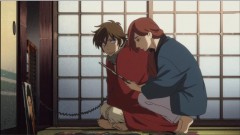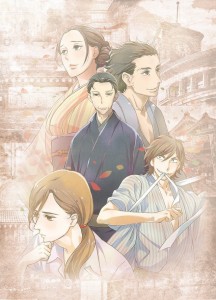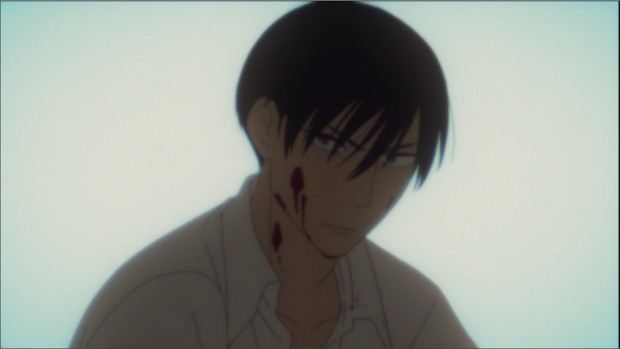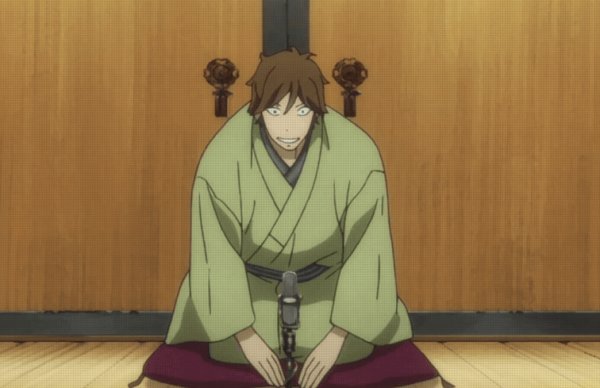 What They Say:
What They Say:
Upon his release from prison, a man seeks out the famous comedic storyteller Yakumo after falling in love with his rendition of a story called “Shinigami.” Yakumo accepts the ex-convict as his apprentice, nicknaming him “Yotaro.” As Yotaro gets acclimated to his new life, he meets Konatsu, a girl in the care of Yakumo who wants to become a performer as well, but is unable to because she is a woman.
The Review:
Content: (please note that content portions of a review may contain spoilers)
Kyoji is a convict fresh out of a stint in prison. With nowhere to go and no family to speak of, he’d normally be in a bind, but something life-changing happened to him while he was in the slammer – Yakumo, the most famous Rakugo performer in Japan, gave a rousing performance of “Shinigami” at the prison, and Kyoji was instantly smitten. It’s been a year now, but that rendition of the story left its mark and Kyoji makes it his first order of business to seek out Yakumo and become his apprentice. Having spent the last of his money on a brand new suit, he seeks Yakumo out and the master seems so amused that he agrees to take Kyoji on, giving him the new name “Yotaro,” or “Fool.”
The thing is, Yakumo has never taken an apprentice, and Yotaro ends up learning more about technique from Konatsu, a young woman living with the master. Konatsu is the daughter of Yakumo’s former associate, another Rakugo performer with very different stylistic inclinations who passed away in his prime. And Konatsu could be a great performer in her own right, but practices in secret as Yakumo refuses to teach her directly. There’s a great deal of strain within the household and Yotaro can sense the tension in the air, but it’s all he can do to prepare for his own performance when his former mob superior shows up and tries to draw him back into a life of organized crime. It takes Yotaro’s passionate enactment to convince his aniki to back off, but afterwards it seems as if Yotaro is set to take control of his life now that these ghosts of the past are no longer haunting him.
Things continue on as usual, with Yakumo taking an aloof stance and Konatsu the more invested one in Yotaro’s practice. Yotaro begins to find himself smitten with the performances of Sukeroku, Konatsu’s father and a man Yotaro finds to be a lot more similar to his innate style. At his next performance, Yotaro apes Sukeroku’s style and the stiffness of the result is uncomfortable to watch. To add insult to injury, Yakumo’s performance that follows is brilliant, but Yotaro’s lack of sleep catches up to him and he audibly snores while the master’s story unfolds. It’s enough for Yakumo to kick Yotaro to the curb, and it’s only after an extreme amount of apology, as well as a pledge to work towards discovering his own Rakugo style, that Yakumo welcomes his student back.
When I first read descriptions of this anime, I felt as if it had my name written all over it. Semi-historical anime with adult characters and quirky or unusual subject matter is pretty rare, and boy is it a niche that I enjoy. As an anime fan looking for something low-key and introspective to watch over the frigid Winter months, I realized soon enough that I had found what I was looking for.
I should first note that this opening episode of the anime comes in at a whopping forty seven minutes and change. While this definitely isn’t unheard of for TV anime, it’s pretty unusual and gives the episode a completely different feel than one would expect from an average premiere. In essence, it is almost a self-contained story of Kyoji/Yotaro’s beginnings as a Rakugo performer, and it stands alone as a great introduction to that aspect of the plot. And yes, this could have been accomplished over two episodes instead of one almost as competently, but the longer run time does offer us something unexpected and completely welcome – a complete Rakugo performance. The scene in which Yotaro performs a story onstage about an incompetent thief, one which he’s been practicing and which we’ve seen him practice unsuccessfully before, is presented in its entirety, and it’s there that the episode really starts to shine.
Most of the Western viewing audience for this series will not be familiar with what exactly Rakugo theater is, and despite having some familiarity with it myself I was slightly worried that the show would end up being too esoteric because of its singular focus on such a lesser-known Japanese theatrical form. It’s the aforementioned scene of Yotaro’s performance that serves to quell these misgivings, as it both serves to explain what Rakugo is (by showing, not telling) and demonstrates the pieces that distinguish good performances from mediocre ones (again, by showing through voice and animation). One very notable aspect of this production is the amount of detail put into animating the characters’ bodies when they’re in the midst of a performance. The shifting of their feet as they sit in the performance area, the change in facial expression and framing when they switch to another character in the story, their hand and arm gestures, the sweat on their brow, these are all relatively minor tweaks to what you’d see in a normal anime series and yet these little bits and pieces do so much to not only enhance the performances themselves but to illuminate the appeal of the art form to groups of people (and even Japanese people) who probably wouldn’t go out of their way to see a live Rakugo performance.
 It would be terrible of me to go without mentioning the Japanese vocal performances in this series, because it becomes very obvious very quickly that without lively and nuanced voice work, even the most sensitive animation could not have portrayed the theatricality of the Rakugo scenes to their full brilliance. It can be difficult to speak about acting in anime, because anime is a medium that truly demands that its performers be over-the-top on a regular basis. Additionally, even someone like me who has experience with the language and can sense some nuance in people’s speaking voices has a hard time judging whether or not voice acting is truly good or mediocre or terrible a lot of the time. But I will say this – the characters in this series, through their storytelling, are required to bring life to several different characters all on their own – men, women, children, wealthy folks, poor folks, villains and heroes, and it was clear enough to me, even staring at these animated drawings, what types of characters were being portrayed and how they fit into the stories and gave them color. I think that definitely deserves some recognition.
It would be terrible of me to go without mentioning the Japanese vocal performances in this series, because it becomes very obvious very quickly that without lively and nuanced voice work, even the most sensitive animation could not have portrayed the theatricality of the Rakugo scenes to their full brilliance. It can be difficult to speak about acting in anime, because anime is a medium that truly demands that its performers be over-the-top on a regular basis. Additionally, even someone like me who has experience with the language and can sense some nuance in people’s speaking voices has a hard time judging whether or not voice acting is truly good or mediocre or terrible a lot of the time. But I will say this – the characters in this series, through their storytelling, are required to bring life to several different characters all on their own – men, women, children, wealthy folks, poor folks, villains and heroes, and it was clear enough to me, even staring at these animated drawings, what types of characters were being portrayed and how they fit into the stories and gave them color. I think that definitely deserves some recognition.
There are a lot of other things going on in this episode and I expect that they’ll all provide enrichment to Yotaro’s narrative. I’m especially interested in Konatsu’s story, especially how it relates to her obvious talent and her tense relationship with Yakumo. There is part of me that worries that the overt sexism she’s experiencing is something that we’ll get beaten over the head with; it’s not a secret that women attempting to enter into the boys’ club of traditional art forms face a steep uphill climb, so it’s not that I believe her story is inaccurate. I just want it to be given the quality treatment that I think it deserves, especially considering that it seems to be secondary to Yotaro’s story and yet I get the impression that it has the potential to be the richer of the two story threads. Yotaro may be reminiscent of Sukeroku and thus be prone to cause Yakumo to face some tough emotional stuff, but Konatsu is Sukeroku’s flesh and blood and presents Yakumo with that challenge on a daily basis. The suggestion of what may have happened around Sukeroku’s death is a juicy tidbit that I can’t wait to chew on later. This trio of characters is already very fascinating to me.
The only reason I had to dock some “points” from this first episode was my impression that some of the humor early on (such as when Kyoji first meets Yakumo by his car) made the characters seem flat and cartoonish in that moment. I was momentarily worried that that scene was setting the tone for the entire episode. While I don’t mind humor in dramatic anime, there are times when it’s misused and it detracts from the overall dramatic tone.
In Summary:
I can generally predict which anime I’m going to like from season to season, but it’s really nice to get confirmation so early on that a great deal of care has been put into creating an anime series that’s so unique from many of its contemporaries and yet is also entertaining and has the potential to cover a lot of very interesting dramatic ground. Selfishly, it’s also great to see a series where the stars aren’t high school kids with the power to save the world, but regular, complicated, fascinating adults to which I can relate. I’m enthusiastically looking forward to what this series will provide in the coming weeks.
Grade: A-
Streamed By: Crunchyroll
Review Equipment:
Samsung Galaxy S5 running the Android Crunchyroll app at 1080p





